Looking for fresh pencil portrait ideas? Try sketching expressive eyes with bold shading, goofy grins, or quirky glasses that add a pop of personality. Use cross-hatching for wild hair, or capture friends mid-laugh, phone in hand. Play with dramatic lighting and geometric shapes, or mix pencils with a splash of watercolor for surprise. Even everyday moments—like homework stress or snacking—can turn into art. Want secrets to drawing unforgettable faces? The next ideas might just spark your imagination.
Key Takeaways
- Focus on drawing expressive eyes and mouths using fine hatching and varied lines to capture intense emotions and unique character traits.
- Enhance portraits with subtle shading, cross-hatching, and layering techniques to create depth, realism, and sophisticated facial expressions.
- Incorporate accessories like glasses or quirky hats, using reflections and shadows to add personality and interest.
- Experiment with geometric shapes, like triangles or squares, to map facial features or overlay abstract patterns for a modern, dynamic effect.
- Draw candid everyday moments—relaxed poses, laughter, or daydreaming—to infuse portraits with authenticity and relatable character.
Harmony in Lines: Blending Nature and Portraiture
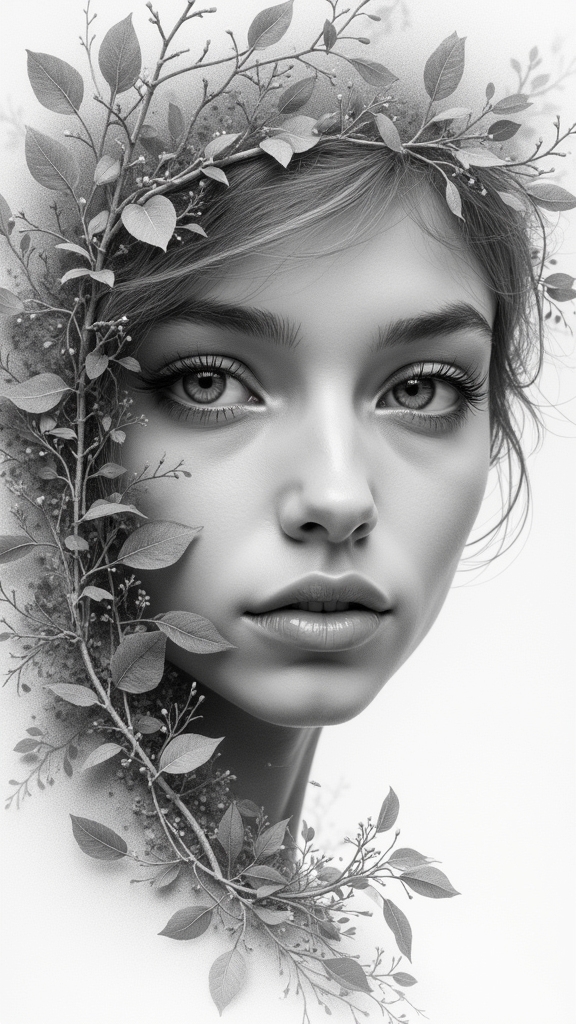
Even though pencil portraits can start with a simple face outline, things get a lot more interesting when nature takes the stage too!
Imagine the wild ride of blending a woman’s delicate profile with blooming flowers—petals twining through her hair, leafy shapes snuggled alongside her jawline. Soft, flowing lines make everything come alive with a sense of gentle movement, while careful light and shadow give the drawing a three-dimensional quality, so it pops off the page.
Every stroke seems full of emotion, letting both the human and nature elements shine. It’s like the portrait is having a heartfelt conversation with nature itself.
Each line breathes feeling, weaving together the beauty of humanity and nature in a tender visual dialogue.
Altogether, these portraits invite viewers to pause and wonder about the magical connection between people and the world around them.
Elevating Expression With Elegant Lines and Shadows
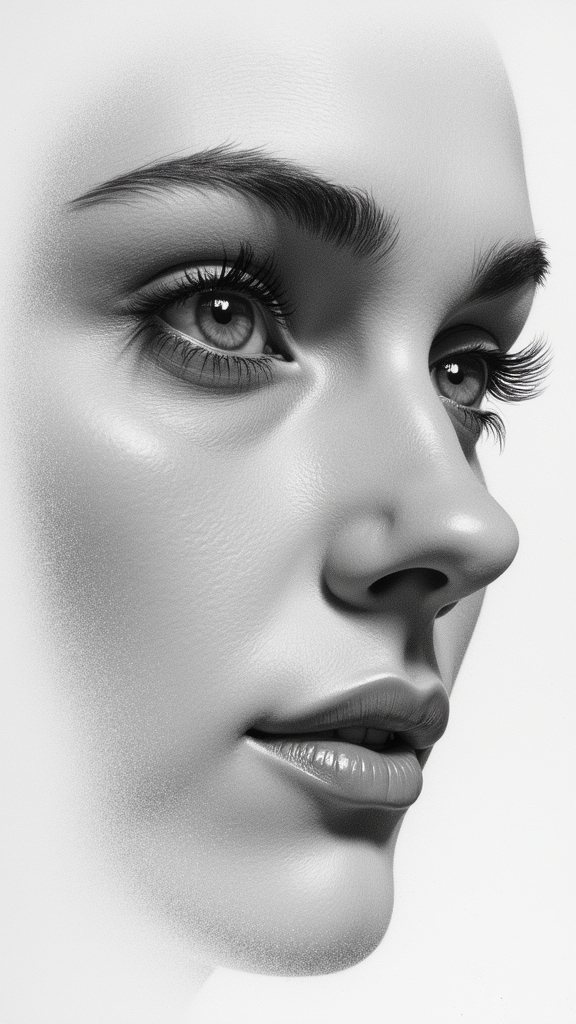
Shading isn’t just for making things look cool—it’s the trick for popping out depth that seems almost magical in a pencil portrait.
When artists focus on tiny details in features like the shine in an eye or the gentle swoop of hair, the whole face starts to feel alive, almost like it could blink or grin right back.
Mixing smooth, graceful lines with bits of shadow and brilliant highlights can turn a simple sketch into something straight-up enchanting.
Capturing Depth With Shading
When drawing a pencil portrait, the magic often happens in the way each line and shadow works together to create something stunning, almost like a secret code artists use to bring people to life on paper.
Shading is like the secret handshake for giving a portrait real depth—it takes a flat face and suddenly makes it pop with dimension.
Artists use super smooth, flowing lines and careful, subtle shading tricks like cross-hatching or layering to add emotion and elegance.
The more they play with light and dark, the more the portrait’s expression seems to jump off the page!
It’s wild how a few well-placed shadows can hint at a sly smile, a worried crease, or a soft, dreamy gaze.
That’s where a drawing truly starts to breathe.
Emphasizing Details in Features
After playing with shadows to give portraits some serious depth, artists start zeroing in on the tiny details that really make each face unique. It’s all about using soft, flowing lines to shape the face, kind of like the great masters did—think of it as extreme contouring without any makeup. Subtle shading, like cross-hatching, lets artists boost texture and depth, bringing Portrait Drawing Ideas to life. The eyes? Oh, they’re mission control for emotion—careful color and line work makes them pop, grabbing anyone’s attention. Lips and noses get special dynamic lines to really nail those clever smiles or mysterious frowns. Clever plays with light and shadow highlight curves, adding some drama and extra style.
| Feature | Line Technique | Expression Impact |
|---|---|---|
| Eyes | Fine hatching | Enchanting gaze |
| Lips | Dynamic curves | Subtle emotion |
| Nose | Flowing contours | Accurate character |
| Cheeks | Soft shading | Gentle expression |
| Jawline | Light contrast | Defined personality |
Depth and Personality: Drawing Portraits With Glasses
Ever wondered why drawing portraits with glasses feels like revealing a new level in art? For many artists, adding glasses is like giving a character a secret superpower—the power of extra personality!
Glasses aren’t just accessories; they’re part of the human form, shaping how a face is remembered. When drawing them, pay close attention to how the frames sit naturally on the nose and line up with the eyes. Reflections and shadows on the lenses bring in that amazing depth, making the portrait pop off the page.
Plus, quirky or bold frames can hint that your character is full of charm or confidence. Don’t forget subtle shading around the eyes. With each delicate pencil stroke, the portrait feels more alive, more real—magic, right?
Bringing Faces to Life With Dynamic Lines
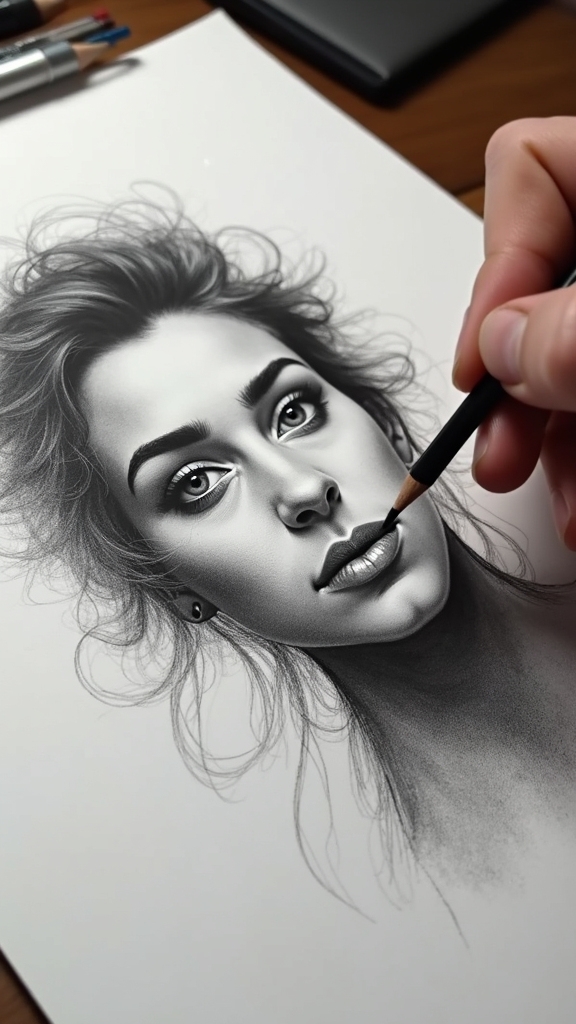
Although some artists play it safe with careful, gentle lines, the real magic happens when bold, dynamic strokes take over the page.
These dynamic strokes can bring even the stillest portraits buzzing to life, like a character about to jump out and start talking. By playing with line pressure and direction, artists can shape fluid expressions that feel real and alive.
Emotive lines around the eyes or mouth—sometimes thick, sometimes whisper-thin—show surprise, laughter, or even mischief without saying a word. Cross-hatching adds a splash of drama, deepening shadows or creating skin texture and a three-dimensional vibe—you almost expect the face to wink.
Experimenting with different line weights turns every portrait into a playground, where every mark reveals a new, unique temperament.
Simple Line Techniques for Capturing Emotion
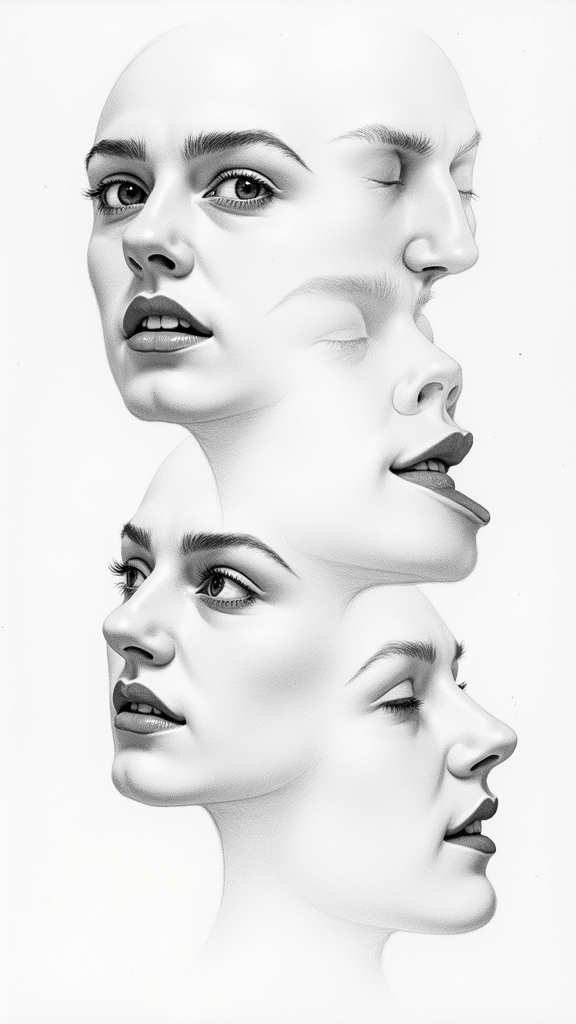
When it comes to showing deep feelings in pencil portraits, sometimes the smallest line can make the biggest impact. By using line variation, artists can give their sketches emotional resonance, making characters look sad, surprised, or even mischievous—all with just a flick of the wrist. Minimalistic expression is powerful: a few well-placed strokes around the eyes or mouth can shout louder than a thousand lines. Cross-hatching helps add depth, while smooth, dynamic lines capture intense feelings. Below is a simple table showing how different line techniques create different moods:
| Line Technique | Emotional Effect | Best Used For |
|---|---|---|
| Thick Bold Lines | Strong, dramatic | Anger, shock |
| Thin Delicate Lines | Softness, vulnerability | Sadness, tenderness |
| Cross-hatching | Complex, layered | Deep thought, tension |
| Fluid Dynamic Lines | Liveliness, excitement | Joy, curiosity |
| Minimalist Strokes | Subtle, silent | Quiet reflection, calm |
The Child’s Gaze: Wonder and Curiosity in Pencil
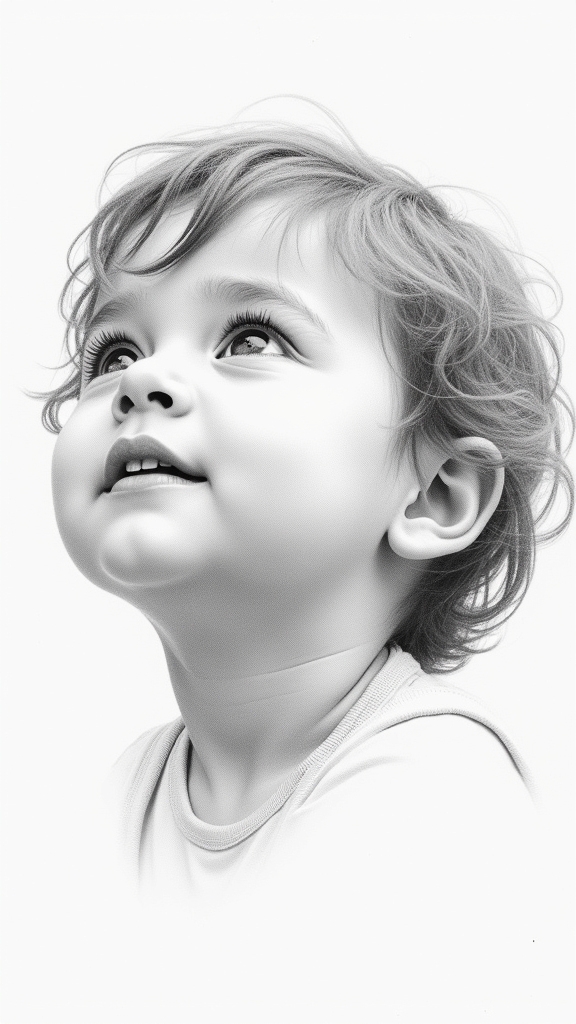
After exploring how lines can show big feelings with just a few strokes, it’s time to fix those pencils on something truly magical—the way a child’s eyes light up with curiosity and wonder.
There’s nothing quite like childhood wonder; it’s almost contagious! In pencil portraits, gaze exploration means really looking at the tiny details—maybe a messy curl falling across a wide-eyed stare, or a grin that says, “What if?”
Layering pencil strokes lets artists build texture, bringing out those bright, searching eyes. Playing with light and shadow helps the gaze leap off the page, giving each child’s look extra depth.
When artists catch that emotional connection, viewers feel like they can hear the kid’s wild questions, sharing a moment of pure, electric curiosity.
Swirling Lines for Dynamic Energy
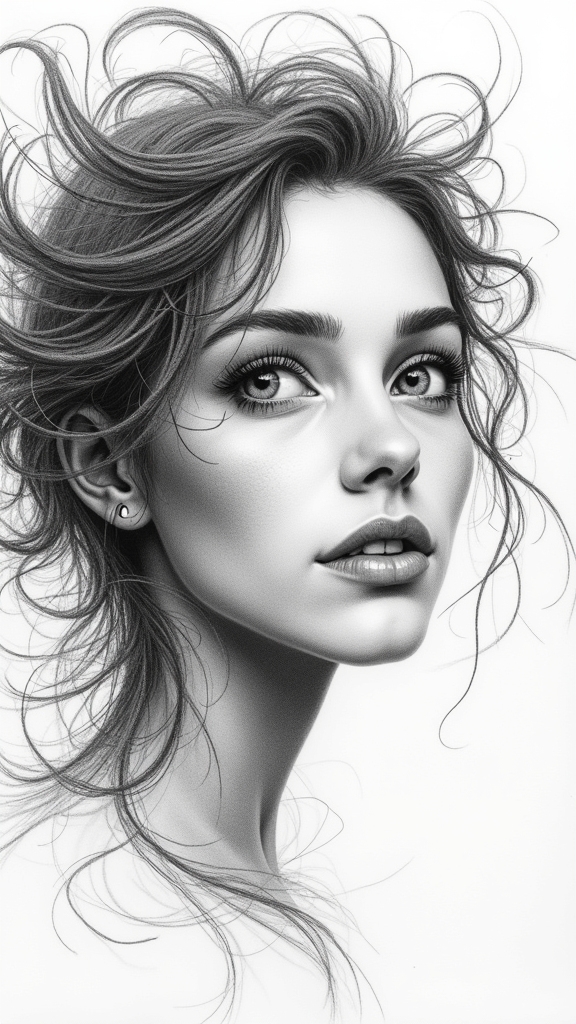
There’s something electric about swirling lines—they burst across the page like a wild dance, turning any pencil portrait into an explosion of life.
Artists who love swirling techniques use them to create energy dynamics that almost make characters leap from the paper. Swirling lines can twirl around the subject, showing emotion or showing off expressive movement—think of it as giving your drawing a cool superpower!
By layering these lines, sketching loosely, or pressing harder for bold swirls, the portrait gains depth and a raw, thrilling vibe. Artists sometimes add rich, contrasting colors to boost the wow-factor, but even in classic pencil, swirling lines pull viewers right into the scene.
Each zigzag and loop becomes a beat, pumping energy into the artwork.
Mastering Light and Shadow With Pencil Work
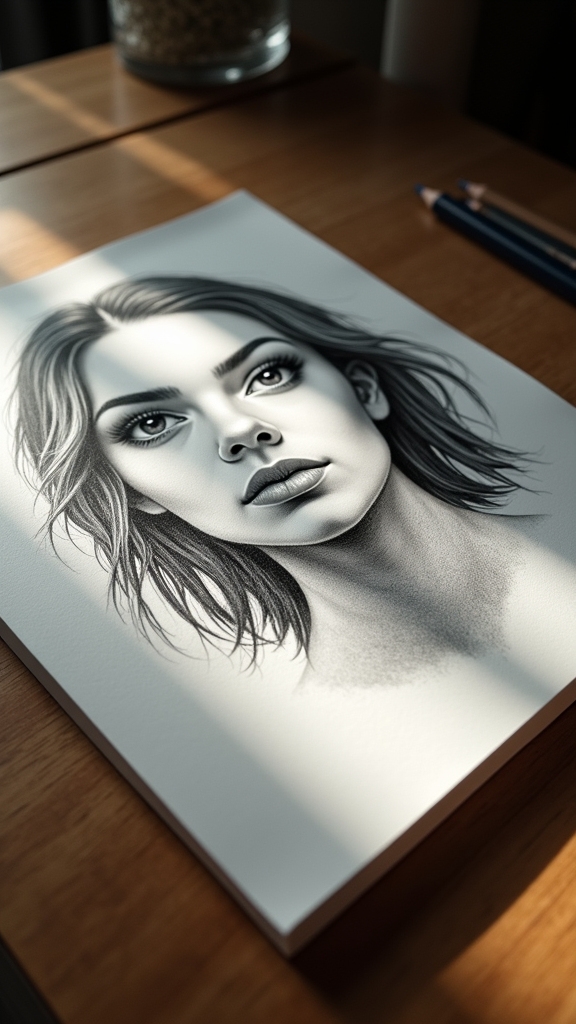
Although it might seem like magic, any artist can make a face look three-dimensional just by understanding where the light hits and where shadows hide.
A real trick is learning light techniques—try squinting at your subject so the highlights and darks become easier to spot. Shadow dynamics are all about building up layers, and cross-hatching is your best friend for smooth changes between light and dark.
Don’t be afraid to press your pencil harder or softer for different textures—think fluffy hair versus sharp creases. The darkest accents, like deep shadows under the nose or around the eyes, add instant depth.
Shading mastery takes tons of practice, so grab photos or a mirror, and sketch a lot. Suddenly, portraits pop with life—no wizard hat required!
Crafting Confidence: Stylish Pencil Portraits
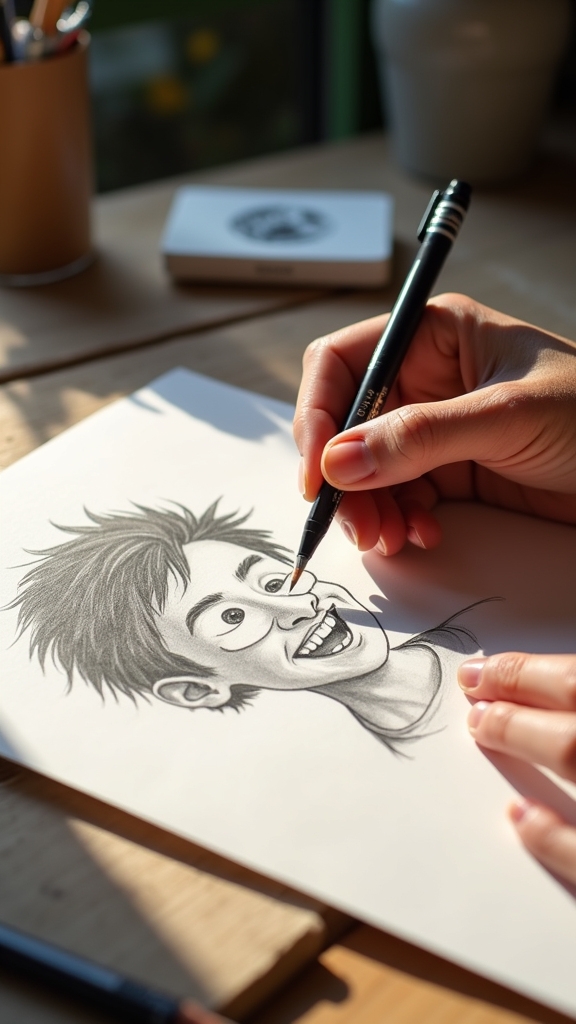
Stylish pencil portraits really come to life when artists zoom in on those expressive eyes—because, let’s face it, a bold stare can tell a thousand stories without saying a word.
Shadowy touches under the cheekbones or along the jawline help build drama and depth, making each face pop right off the page. Toss in some oversized glasses or playful earrings, and suddenly, that portrait doesn’t just have confidence—it’s practically strutting off your sketchbook!
Capturing Expressive Eye Details
Every pencil portrait gets a serious boost from eyes that seem to leap right off the page—eyes can totally make or break that feeling of confidence or cool.
The secret? Start with eye shape analysis—don’t just draw an oval; think about the full circle of the eyeball and how it’s tucked into the face.
Next comes eyelid contouring: those soft, flowing lines around the lids and lashes are like magic tricks for showing emotion or sass. Notice the little curves and angles; even a tiny tilt can change everything!
And don’t forget emotional reflections. By using a kneaded eraser to lift highlights in the iris, artists can add sparkle—instant character, instant mood.
When the eyes shine, so does the portrait!
Enhancing Depth With Shadows
Shadow—a simple word, but in pencil art portraits, it’s where the magic really happens.
With shadow play techniques, artists can transform a flat face on paper into something almost alive. Carefully choosing where the shadows fall around eyes, nose, and lips boosts the three-dimensional feel, making it nearly pop off the page.
It’s all about tonal value exploration—pressing harder or lighter with the pencil changes the mood and shows off the skill. Highlights and deep, dark areas create emotional contrast effects that turn a so-so drawing into real art.
Dynamic cross-hatching adds grit and texture, while subtle shading quietly brings out confidence and attitude in a character.
In short, strong shadows aren’t just about darkness; they’re about making the whole portrait shine.
Conveying Personality Through Accessories
A single, well-placed accessory can say more about someone than a thousand words ever could. Picture a pencil portrait with oversized, quirky accessories like giant glasses or a silly hat—suddenly, the character’s confidence and individuality just pop!
Texture variation matters, too. Drawing smooth necklaces or rough, scratchy scarves helps each accessory stand out, making the artwork way more interesting to look at. Accessories aren’t just decorations, either; they become symbolic elements, hinting at the character’s hobbies or dreams.
Maybe those headphones mean someone’s a music lover, or a funky pin reveals a secret passion for frogs (hey, it happens). Playing with angles or adding subtle shading around these details can give the portrait depth, realism, and a boatload of personality.
Soft Textures and Delicate Features in Portraits
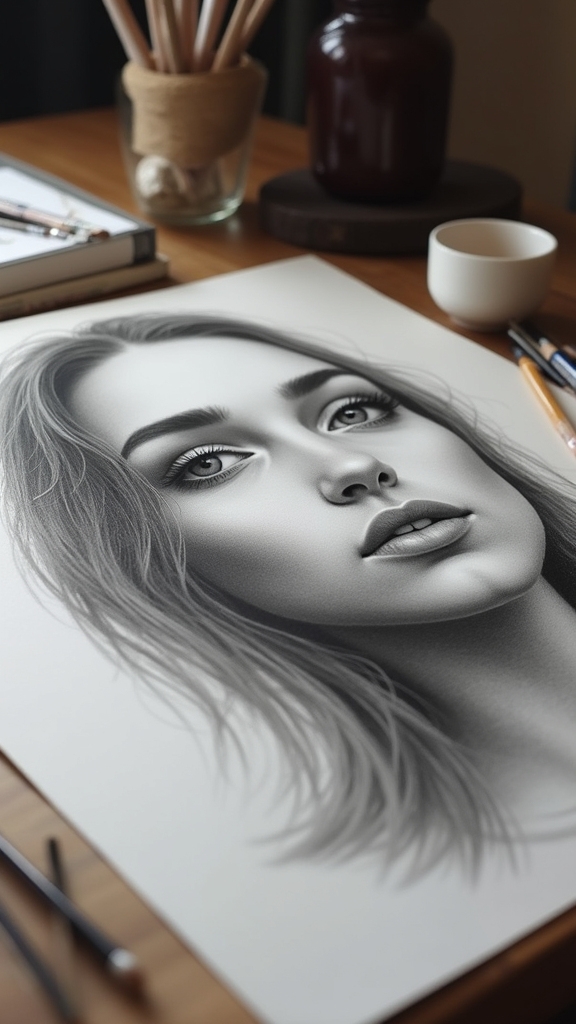
When an artist sets out to draw a pencil portrait with soft textures and delicate features, it’s almost like they’re telling a secret in slow, quiet whispers. Soft shading techniques help bring out delicate facial contours—think of the smooth shadow under a cheekbone or the gentle curve of a smile. Pencil grades play a sneaky role here: a 2H creates feathery lines, while a 6B goes bold, perfect for those deep, realistic texture applications. Nailing the light and shadow makes everything pop without breaking the calm vibe. Artists love to use reference images to make sure every eyelash and eyebrow looks true. Every stroke matters, even when it’s so delicate you could almost miss it.
| Technique | Effect Achieved |
|---|---|
| Soft Shading Techniques | Gentle shifts, peaceful skin tones |
| Cross-Hatching | Subtle depth in eyes, lips, and noses |
| Pencil Grades (2H–6B) | Varied softness for natural-looking textures |
| Light and Shadow Balance | Enhanced three-dimensional facial details |
| Reference Images | Ultra-realistic, nuanced portrait features |
Expressive Mixed Media: Watercolor Meets Sketch
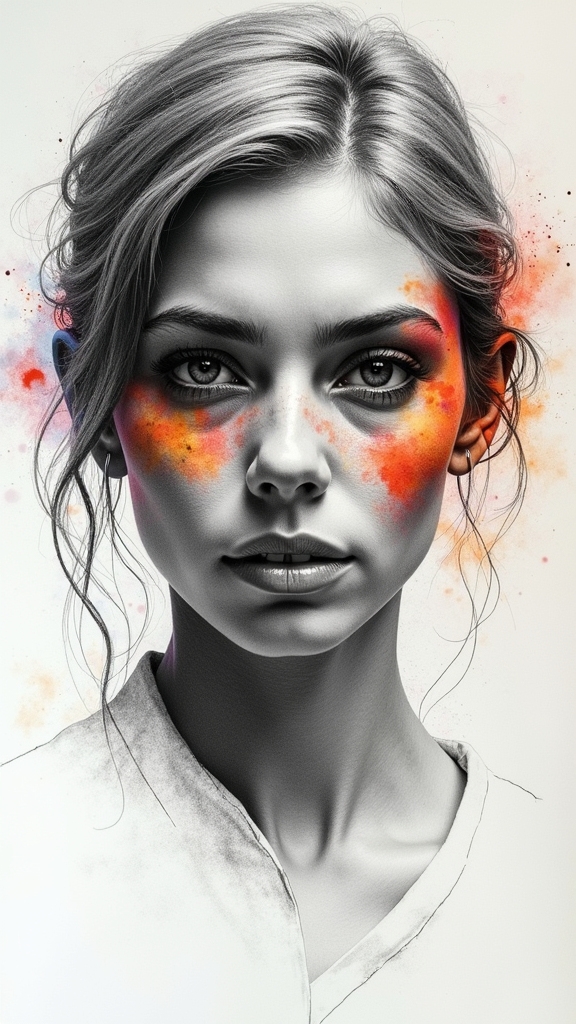
When watercolor meets pencil sketch, portraits can feel totally alive—like the page itself is catching its breath.
Layering soft washes of color on top of sharp pencil lines makes emotions pop in ways plain sketches just can’t match.
Layering Pencil and Watercolor
Even though pencils and watercolors seem like total opposites—one crisp and sharp, the other splashy and wild—they team up in mixed media portraits to create something seriously cool.
Layering techniques are where the magic happens. Artists usually start with a detailed pencil drawing, locking in those important outlines and features.
Then comes the fun part: adding watercolor washes. By keeping the color light at first, it’s easy to let the pencil lines peek through and actually work with the color.
Color interaction gets wild when you use blending methods like wet-on-dry for sharp edges, or wet-on-wet for softer, dreamy backgrounds.
Pencil is great for teeny, tricky details, while watercolor covers bigger spots with energy—together, they really bring portraits to life!
Enhancing Emotion With Color
Although pencil portraits already have the power to capture someone’s likeness, things really get interesting once watercolor joins the party. Suddenly, color symbolism takes the spotlight.
Want the portrait to feel warm and friendly? Try a palette selection of reds and yellows. Going for a peaceful vibe? Blues and greens are your pals.
With watercolor, backgrounds can be soft and dreamy, making pencil lines pop—almost like the subject is stepping out of a memory. Layering washes adds texture, making the artwork multi-dimensional, like 3D glasses for your feelings.
The real magic happens when an artist uses color to turn up the emotional resonance, letting viewers “feel” a portrait rather than just seeing it. Now, who knew a little paint could get so emotional?
Integrating Intricate Patterns Into Portrait Art
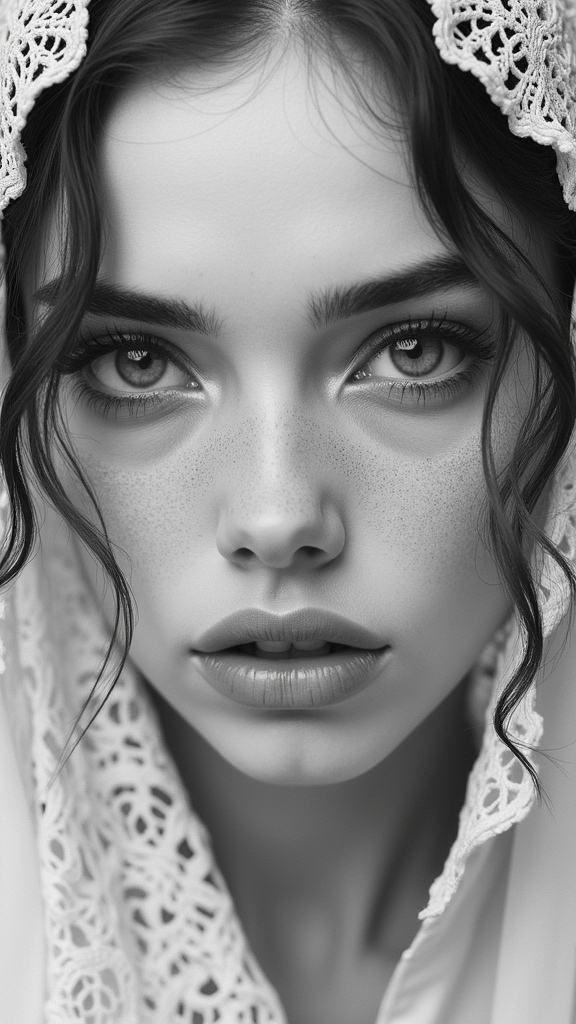
Working intricate patterns into pencil portrait art is like adding secret codes to a story—it makes the whole picture way more interesting and, honestly, a lot more fun to look at.
When artists weave patterns across a face, hair, or even the background, they’re diving into some serious texture exploration. Those swirls, lines, and tiny shapes can totally change how a portrait feels.
It’s not just about looking cool, either; each shape can carry some pattern symbolism, like zigzags for energy or flowing lines for calm vibes. Suddenly, a simple drawing turns into epic visual storytelling.
Every detail might hint at the person’s personality or secret dreams. If you spot a pattern in a portrait, ask yourself—what story does that pattern want to tell?
Geometric Approaches to Modern Pencil Portraits
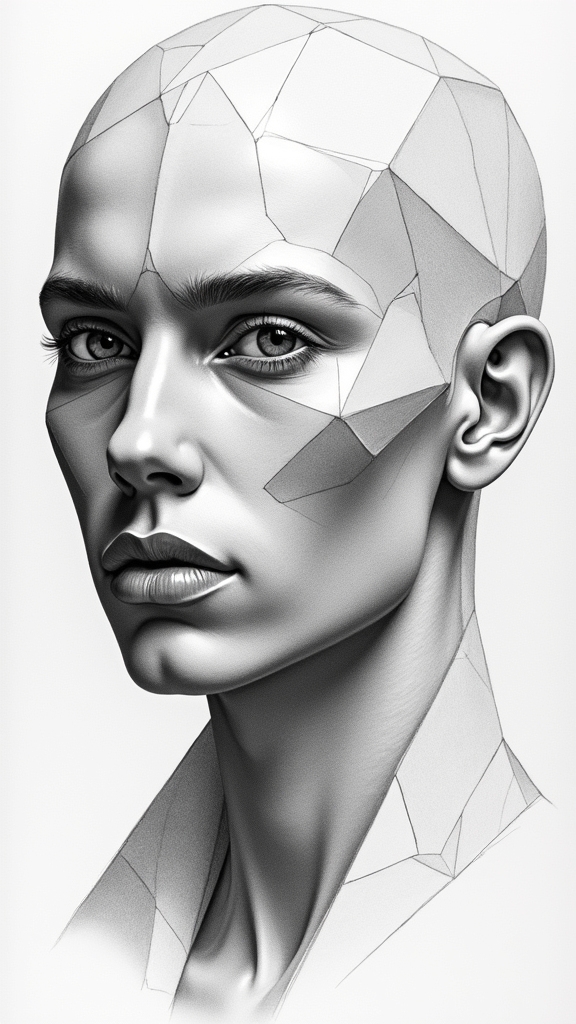
When artists use triangles to map out facial features, it’s like turning someone’s face into a secret code of shapes—seriously cool and a little mind-bending.
Throw in some wild, abstract patterns to build up shadows or highlights, and suddenly that portrait has a whole new level of depth that messes with your expectations.
This mix of math and art makes each pencil portrait feel fresh, surprising, and just a little bit rebellious.
Triangular Facial Structure Mapping
Triangles might not sound like the secret to realistic pencil portraits, but in the world of geometric art, they’re total game-changers! By using triangular symmetry, artists break down faces into cool shapes, making facial geometry way less mysterious.
With this trick, they can easily spot how the chin, cheekbones, and forehead line up—no more guessing where that nose should go! It’s all about achieving those winning artistic proportions without sweating every single line.
When artists sketch out these triangle patterns on a face, it’s like a hidden map, guiding them to capture someone’s likeness and character. Plus, the triangular approach gives portraits a fresh, modern vibe, moving away from traditional realism.
Experimentation with angles suddenly feels a lot more approachable—and even pretty fun!
Abstract Patterns for Depth
Although it might sound wild at first, adding abstract patterns to pencil portraits totally flips the usual rules on their head. Instead of just shading cheeks or outlining jaws, artists immerse themselves in abstract pattern exploration—filling faces with wild, geometric shapes like triangles, squares, or even zigzags.
This geometric shape integration doesn’t just look cool; it actually adds a crazy amount of depth. Each section can use different techniques, like cross-hatching or wild line weights, turning the whole portrait into a kind of emotional jigsaw puzzle. These emotional resonance techniques make the viewer feel more with each layer.
Adding color or overlapping patterns can push things even further, making portraits bold, mysterious, and way more modern. It’s classic art with a brand-new twist!
Everyday Moments: Realism in Casual Self-Portraits
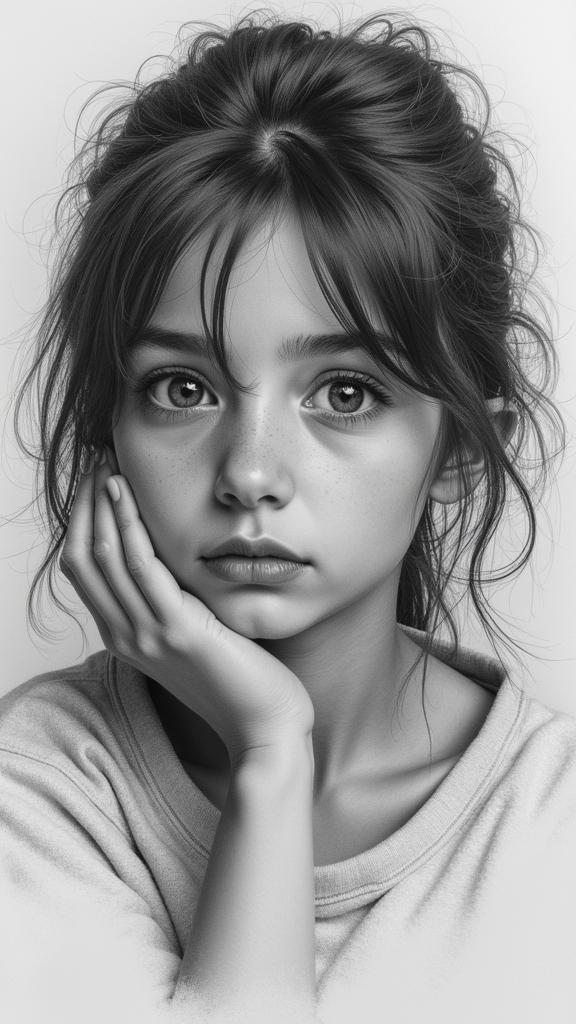
Even on the messiest of days, there’s something seriously awesome about turning everyday moments into self-portraits—especially the kind that look totally real.
Capturing candid moments and everyday expressions brings a whole new level of relatable storytelling to pencil art. Artists don’t have to look perfect: maybe they’re yawning, reading, or even struggling with a snack. That’s the magic—these sketches show real life, not just “camera-ready” faces.
Sketches of messy moments and real expressions tell honest stories—showing life beyond perfect poses and polished selfies.
By playing around with different pencils, artists can add cool shadows and make their portraits pop with realism. Here’s what a casual self-portrait might include:
- Slouching on the couch with a phone in hand
- Daydreaming out a rainy window
- Laughing mid-bite at breakfast
- Eyes half-closed, struggling with homework
- Wild hair, cozy hoodie, genuine grin
Frequently Asked Questions
How Do You Make Pencil Portraits More Realistic?
To make pencil portraits more realistic, one should use effective shading techniques, study reference images closely, and apply careful blending methods. Attention to accurate proportions and subtle differences in tone further enhances depth, texture, and lifelike appearance.
What Do You Draw First When Drawing a Character?
When drawing a character, an artist typically starts with basic shapes to establish the head and body structure. They then create guidelines for facial features and character poses, ensuring accurate expression conveyance before refining individual features and details.
What Can I Draw in 5 Minutes?
A five-minute session allows practice with quick sketch techniques, focusing on capturing simple character expressions and experimenting with rapid shading methods. Artists often draw dynamic poses, basic facial outlines, and accessories to efficiently convey emotion and personality within time constraints.
Which Drawing Is Trending Now?
The current question focuses on trending drawings, with popular styles frequently emerging on social media and through art challenges. Dynamic line work, expressive faces, and creative pattern integration are consistently gaining traction and engagement in online art communities.
Conclusion
Pencil portraits aren’t just about copying a face—they’re about telling a story, capturing a mood, or even adding a little twist, like funky glasses or wild patterns. With all these ideas, anyone can turn a blank page into something alive and personal. So, grab a pencil and get started! Who knows? Your next drawing might surprise you, or at least give you a good laugh if the eyes end up a little lopsided. That’s the fun of it!

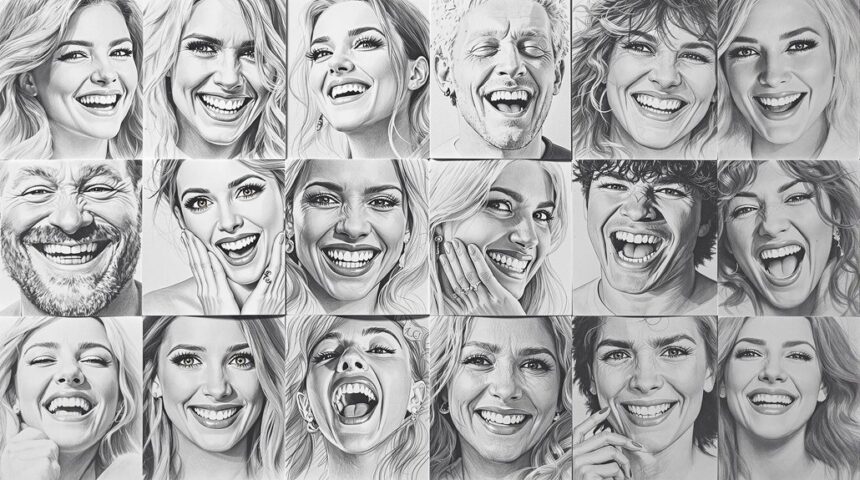
Leave a Reply